Iran is a country with a rich history full of ups and downs. Therefore, each museum in Iran represents a part of this long history, and visiting them can greatly immerse us in what has happened over time. One of the most famous museums of Iran is the Iran National Jewels Museum, originally the Iran Crown Jewels, which is located in the basement of the Central Bank of Iran. It houses royal jewelry and historical objects from ancient periods to modern times and is open to the public.
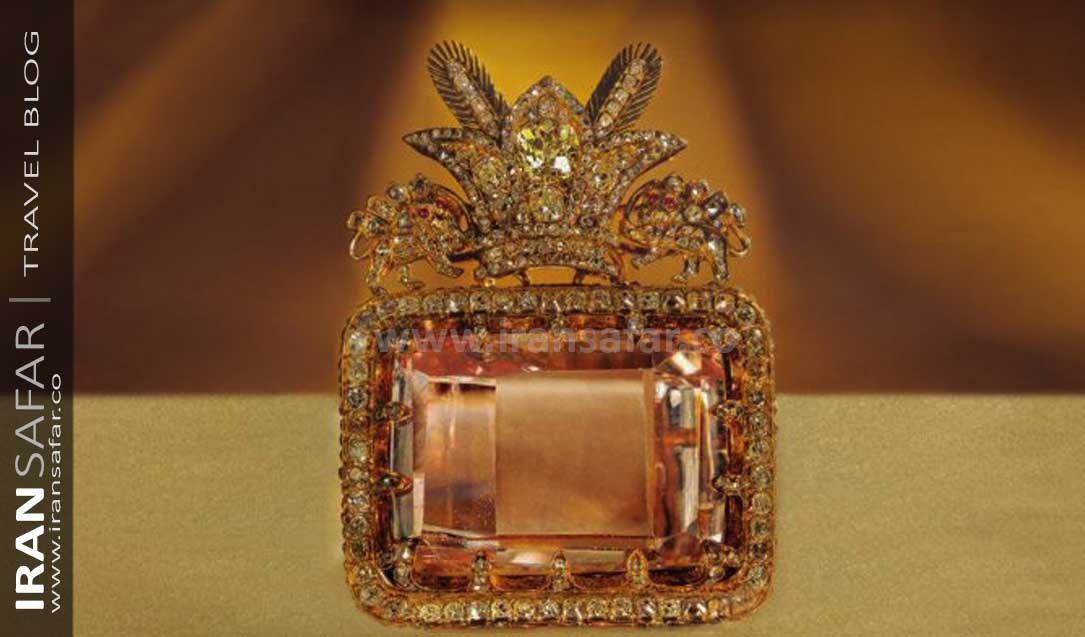
Iran National Jewels – Introduction
The Iran National Jewels Museum is one of the most attractive tourist destinations in Tehran, which preserves the exquisite treasures of crown jewels under the title of National Treasury. The unique and valuable objects that exist today in Iran’s National Museum of Jewelry are a mixed collection of the history and art of this land. All over the world, from ancient times to the present, jewelry has been collected to be both a display of power and to enrich the treasury of kings and governments. But especially in Iran, perhaps the history of collecting precious gems dates back to the Safavid era because prior to the Safavid period, no action was taken to collect and protect jewelry, gems and precious ornamental stones in Iran. During the Safavid Empire period, kings sent ambassadors to neighboring countries to buy, collect, and preserve existing and purchased jewelry.
History of Iran National Jewels
The collection of national treasures of Iran developed during the Qajar period (19th century). It was during this period that jewelry design was supported and developed for the first time. Iranian and Armenian designers and jewel makers were invited to the court, and the making and collection of exquisite gifts and the precise classification of government treasury jewelry started. Kiani crown, Naderi throne, Jewel Globe and Peacock Throne (Sun Throne) are among the treasures of this period. Neyshabour turquoise and the Persian Gulf pearls were gradually added to the precious collections.
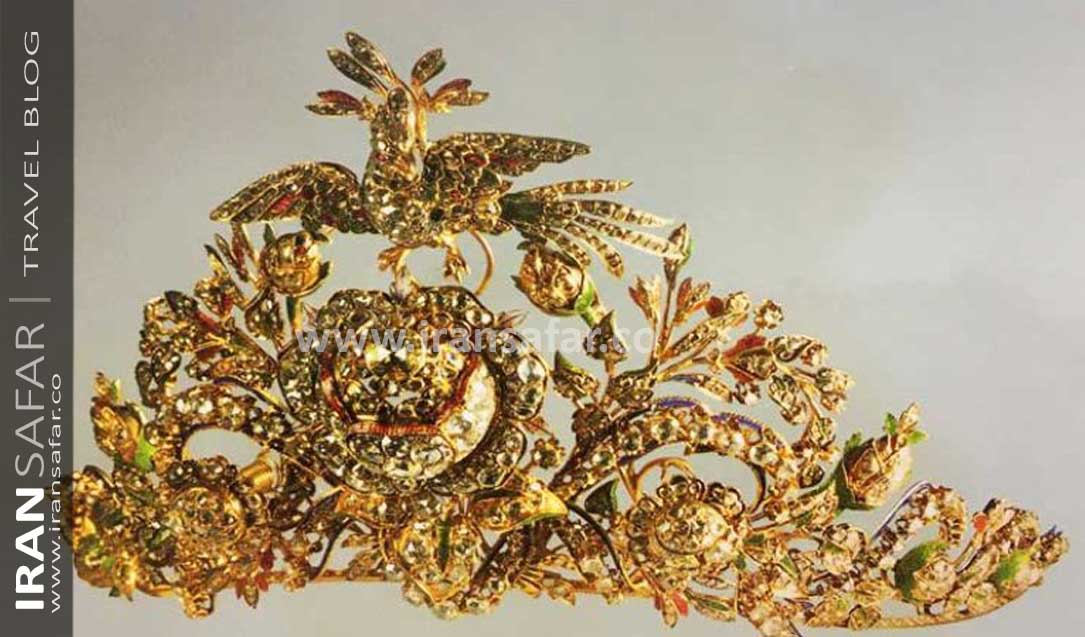
The Iran National Jewels stand as a shimmering testament to the country’s illustrious history and cultural heritage. From ancient origins to modern times, these treasures continue to dazzle and captivate all who behold them. Their preservation and public display offer a glimpse into the opulence and grandeur of a bygone era, reminding us of the enduring legacy of rich history of Iran.
These royal jewels and exquisite gems were kept in Golestan Palace during the Qajar period and then in the basement of Marble Palace (Kakh-e Marmar) during the first Pahlavi period. In 1937, during the reign of Reza Shah Pahlavi, the ownership of the Imperial treasury was transferred to the state and after the completion of Iran National Bank (Bank Meli) building, the jewels were placed in the vaults of the National Bank of Iran, where they were used as collateral to strengthen the financial power of the institution and to back the national monetary system. This important economic role is perhaps one reason why these jewels, undeniable symbols of Iran’s monarchic past, have been retained by the current Islamic Republic.
Today, the Iran National Jewels museum is protected by the Central Bank of the Islamic Republic of Iran and its unique collection exposes many jewels of the Safavid, Afsharid, Qajar and Pahlavi dynasties to the public.
Also Read : National Museum of Iran
The Iranian Crown Jewels Value
In terms of artistic value, history and uniqueness, Iran national jewelry museum’s collection is in a situation where even the best experts and evaluators in the world have not been able to calculate its true or approximate value. It contains some unique gems and jewels that have no equal in the world. Even the world’s most expert evaluators have not been able to calculate any value for this treasure. However, the value of the collection is not limited to the economical aspect of them. The cultural value of the items that reflect the history, unique designs, creativity, and imagination of the artists is something not to be undermined.
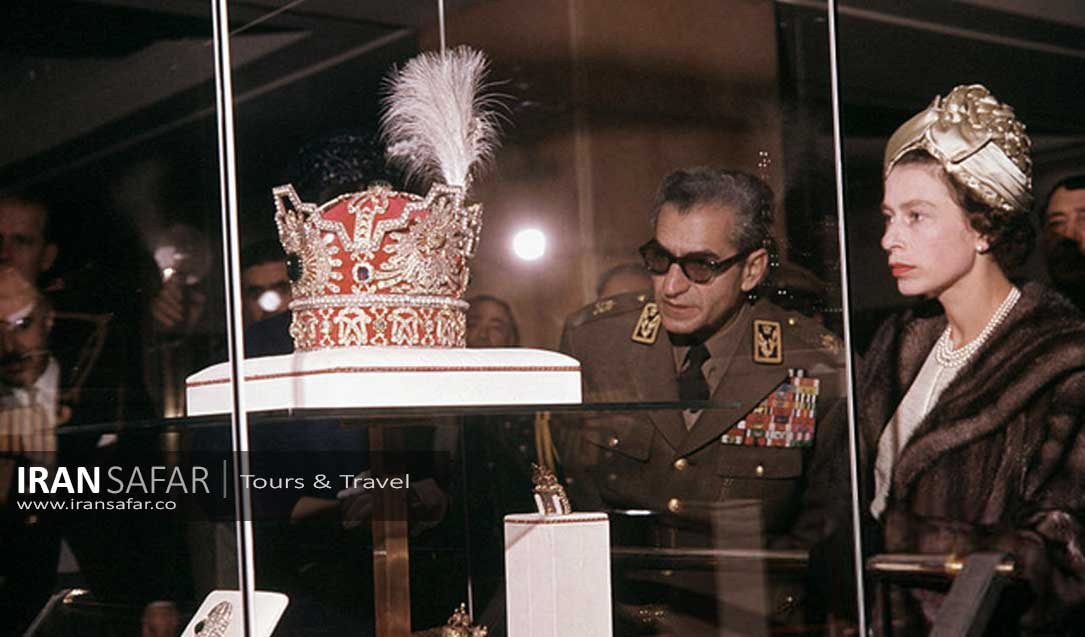 Queen Elizabeth II and the Shah of Iran, 1961, The national jewels treasury, Tehran
Queen Elizabeth II and the Shah of Iran, 1961, The national jewels treasury, Tehran
Peacock Throne
Another luxurious treasure found in the national treasury of crown jewels is the huge and famous Peacock Throne (throne of the sun). This throne was built in 1798 by the order of Fath Ali Shah. This throne is adorned with 26,733 gems, including an extravagant carved sun on the top of the throne studded with precious diamonds. That is why this throne was originally called the throne of the sun, but later became known as the peacock throne (Takht-e Tavoos) on the occasion of Fath Ali Shah’s marriage to a woman called Tavoos Taj al-Dawlah and the throne became known as the Peacock Throne in her honor.
Of course, most Iranians thought that this throne was the same as the Indian peacock throne of the Mughal king Shah-i Jahan but further research showed that this unique work was made by the order of Iranian Qajar king Fath Ali Shah and has nothing to do with the Indian peacock throne.
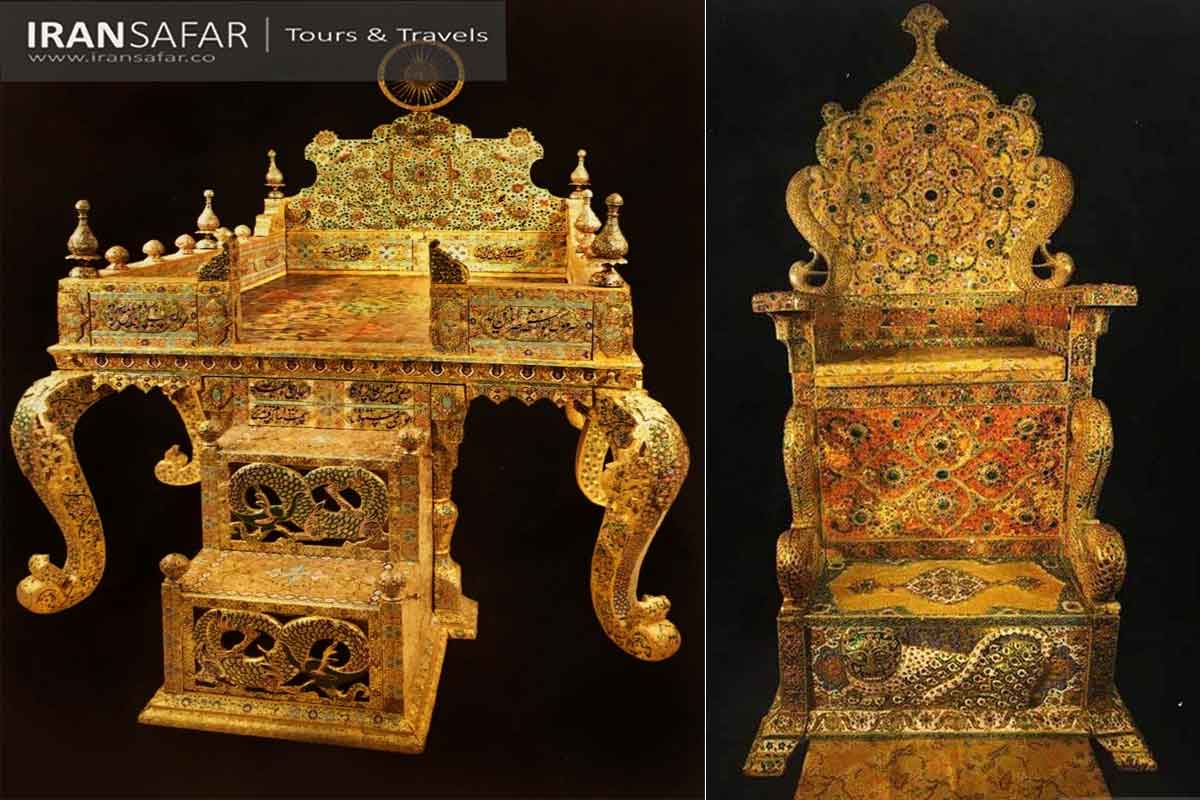
Left: Peacock Throne | Right: Naderi Throne
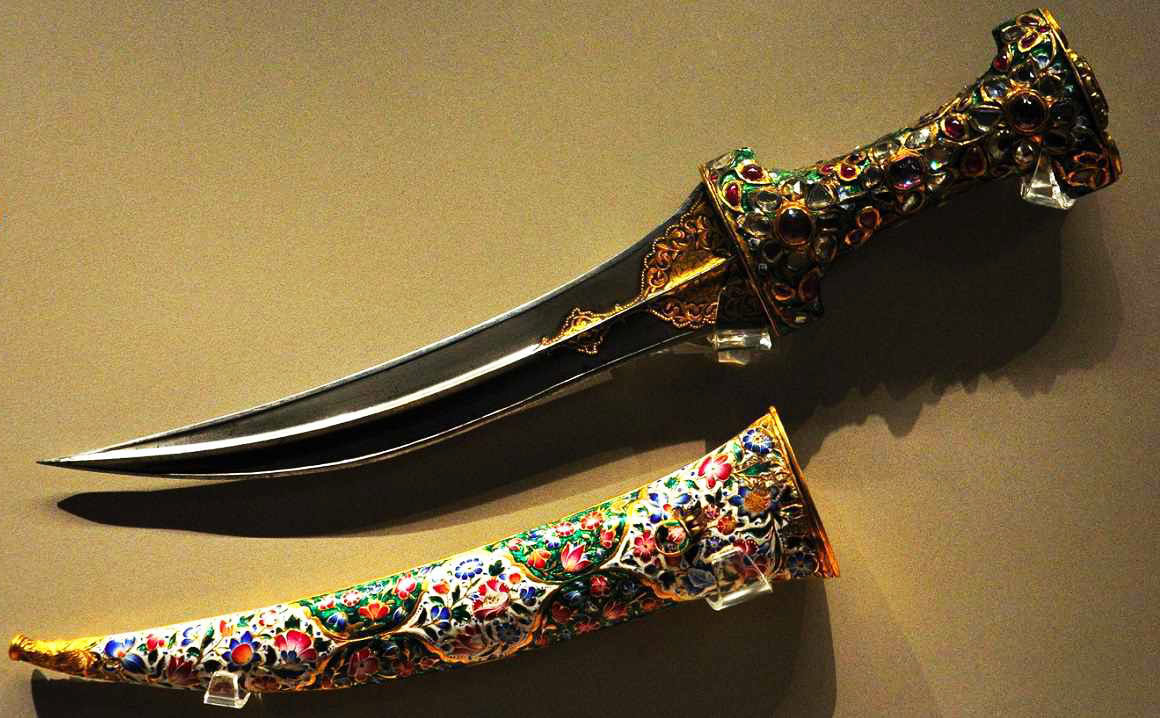
Nader Shah’s Shield
One of the special objects of the jewelry treasury is Nader Shah’s shield, which he used in various wars. 46 cm in diameter, this shield is covered with rhino skin and is studded with emeralds, rubies and diamonds. Initially, it had a simple cover; But later, like the sword, it was ornamented by the order of Fath Ali Shah Qajar. In the center of this shield you will see one of the largest rubies in the world, weighing 225 carats, surrounded by a star of rows of diamonds, rubies and emeralds.
Darya-i Noor
This diamond may be the first among the national jewels of Iran. This famous diamond and the diamond of Kuh-i Noor, apparently due to the closeness of the name, have always been considered a couple, while in terms of cut and color, they have nothing in common with each other. Both gems were brought to Iran by Nader Shah from his Delhi conquest, but the diamond of Kuh-i Noor was stolen and taken to Afghanistan after Nader’s death. It was later presented to Queen Victoria by the East India Company. The gem is still on the crown of Queen Elizabeth II, the current Queen of England.
After Nader Shah’s assassination, the Darya-i Noor diamond passed to his grandson Shahrukh Mirza, and later to Lotfali Khan Zand. When Lotfali Khan was defeated by Qajars, the gem was transferred to the Qajar jewelry treasury and now adorns the crown jewels Treasury. Darya-i Noor weighs 182 carats and its color is pink, which is the rarest color of diamonds.
Jeweled Globe
Located at the end of the treasury hall, another most valuable treasure of the National Jewelry Museum is the jeweled Globe that fascinates visitors. This globe was made in 1874, by the order of Nasser al-Din Shah, and by a group of Iranian jewelers. The net weight of the gold used in this item is 34 kg and the weight of its jewelry is 3,656 grams. The total number of jewels installed on the globe is 51,366 pieces. The seas and oceans on the globe are represented by emeralds and the lands by rubies, diamonds and sapphire. Southeast Asia, Iran and the United Kingdom are marked with diamonds, India with rubies and Central and South Africa with sapphires.
Pahlavi Crown
This crown, which was made in the shape of the crown of the Sassanian kings, was used by Reza Shah and Mohammad Reza Pahlavi. Made of gold and silver, this crown is adorned with high quality diamonds, large emeralds, rubies and pearls.
The crown that was previously used in the coronations of the Qajar period was the Kiani crown, but Reza Khan Pahlavi did not want to use it in his coronation. Therefore, in 1925, a group of Iranian jewelers, under the supervision of Sirajuddin Javaheri, the famous Caucasian jeweler and jeweler Amir Bukhara, who had emigrated from Russia to Iran, made the crown from selected gems. Inspiration for the new design was drawn from paintings and historical references to crowns used during the Sasanian Empire, which had ruled Persia from 224 to 651 AD.
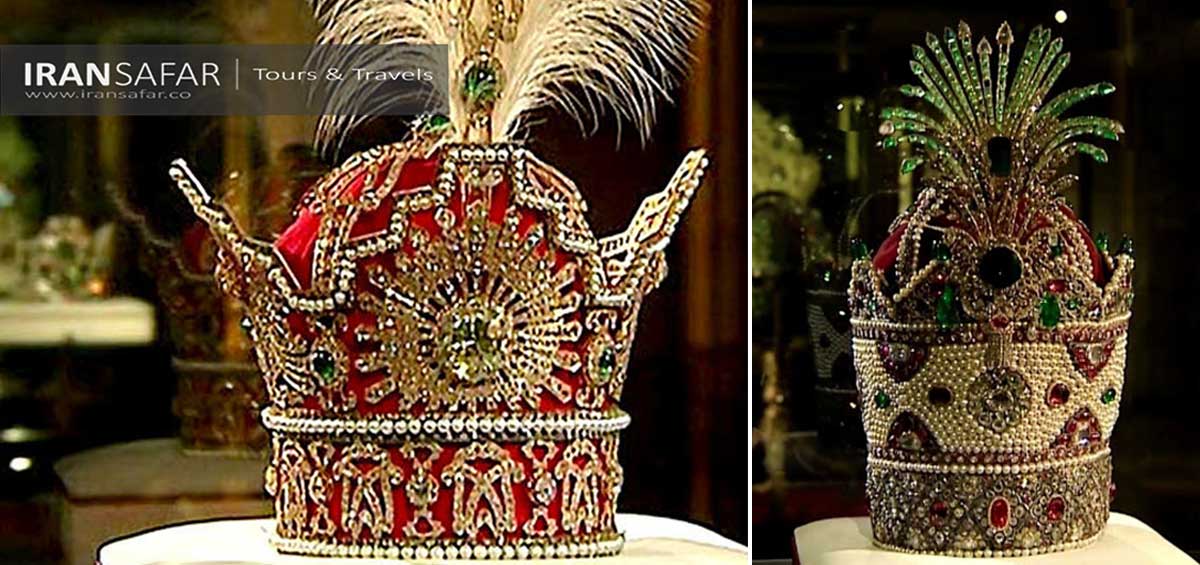 Left: Pahlavi Crown | Right: Kiani Crown
Left: Pahlavi Crown | Right: Kiani Crown
Also Read : Sa’adabad Palace Complex
Kiani Crown
The crown of Fath Ali Shah, known as the Kiani crown, is adorned with diamonds, emeralds, rubies and pearls. This crown was made during the reign of Fath Ali Shah and was used by Qajar kings. This crown is the first crown that has been made in this way after the Sasanian Empire.
Farah Diba’s Crown
Among the other well-known royal jewels of Iran National jewels museum’s treasury, is the crown of former Queen Farah Pahlavi. One of the reform plans of Mohammad Reza Shah was to introduce his wife as his regent. Accordingly, in occasion of his own coronation, the Shah decided to have a separated ceremony to crown the queen. An effort that had never been done before in Iran. A French jeweler Gallery, Van Cleef & Arpels, was appointed to design and make the crown by using precious gems from Iranian royal treasury. The crown is adorned with 36 green emeralds, 105 pearls, 34 red rubies, 2 spinels, and 1,469 diamonds. It has a white gold frame over a green velvet cap. A 92-carat green emerald on the front center gives it a dazzling glow. Queen Farah described the crown as beautiful, yet very heavy, weighing two kilograms.
Also Read : Niavaran Palace Complex
Nur al-Ayn Tiara
Of the most remarkable pieces in Iran National Jewels museum is the Nur al-Ayn Tiara, made for queen Farah Pahlavi, Mohammad Reza Shah’s last wife. This royal tiara is an iconic and fine work of renowned American jeweler Harry Winston. Worn by Farah in occasion of her wedding in 1959, the tiara was well-known for its rare pink diamond, the Nur-al Ayn. In research on both diamonds of Darya-i Noor and the Nur-al Ayn, scientists concluded that they were originally one piece and were later divided into two. The large piece is the Darya-e Noor diamond, and the smaller piece weighing 60 carats is the Nur- al-Ayn.
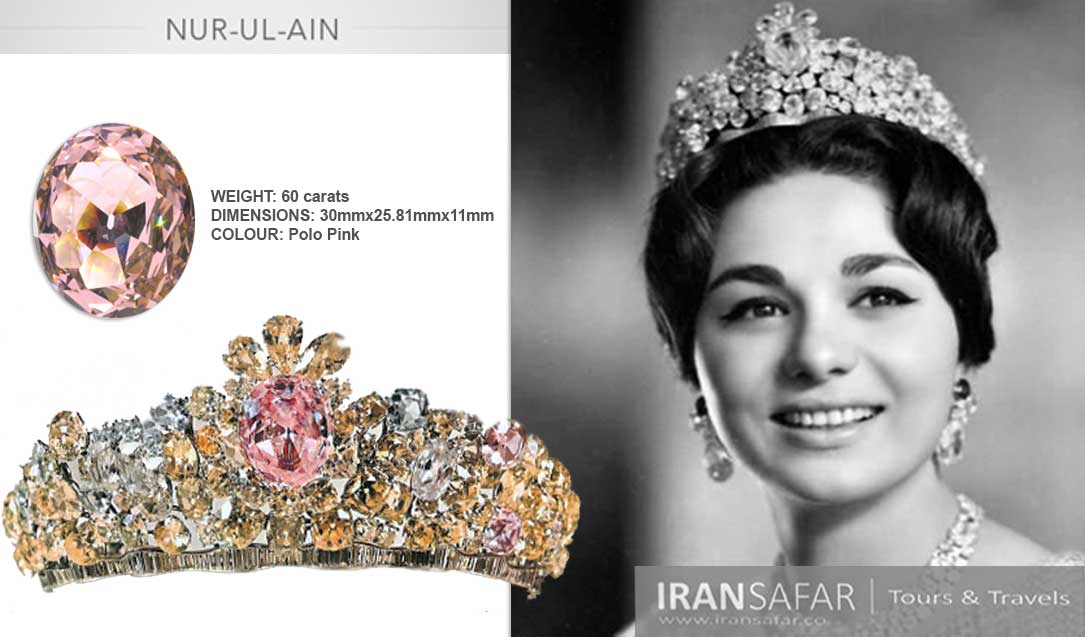
Farah Diba’s tiara adorned with Nur Al-Ain pink diamond
The Golden Belt
The belt is a 119 cm long gold strap with a unique and shining elliptical emerald weighing 176 carats. The emerald adorned with 60 pieces of Brilliant diamonds, and 145 pieces of Flamenco diamonds, gives a stunning shine to the belt. Nasser al-Din Shah of Qajar used the Golden belt in occasion of official ceremonies.
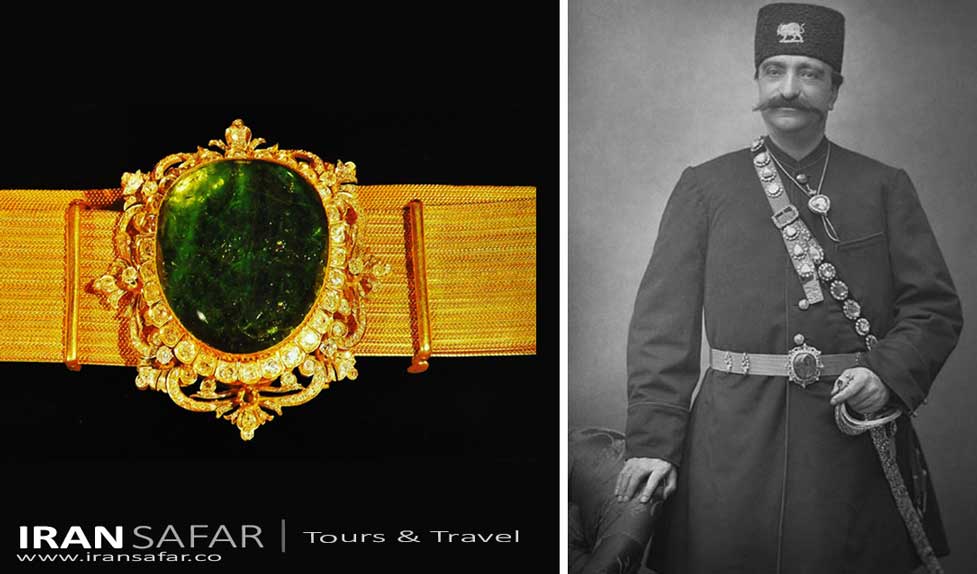 Golden belt of Naser Al-din Shah
Golden belt of Naser Al-din Shah

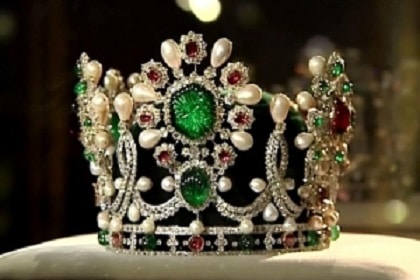
The Jewelry Museum is the most valuable museum in Iran and seeing all this beauty is a must. Darya-e-Noor diamond is a masterpiece and is kept in this museum
Iran great history. Created with will of LORD./ HOLLY LAND.